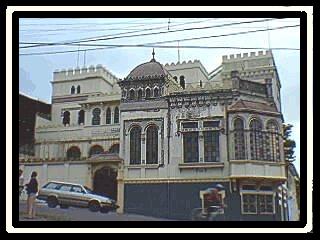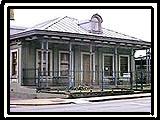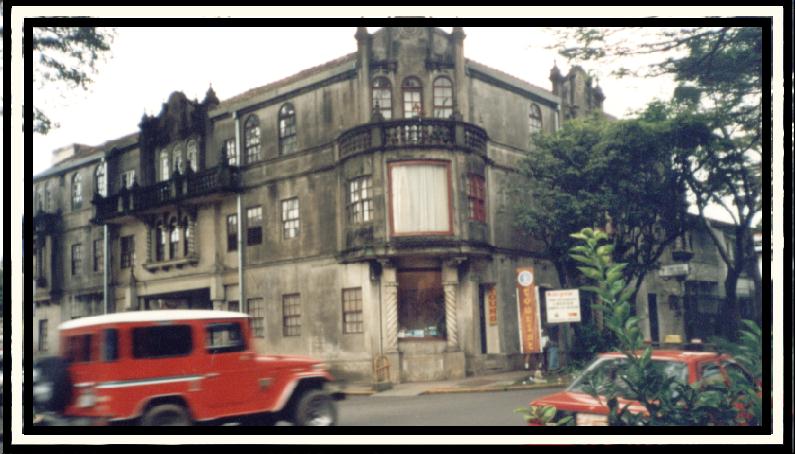 
 
 
 
 
 
 
 
 
 
 
 
 
 
 
 
 
 
 
 
 
|  |
BUILDINGS

Bishop Palace -[Av. 13/calle 3]. It`s built in 1930 in ornamental Moorish style by Anastasio Herrero. The majority of building materials were brought from Italy and Spain. It`s distinguished by small turrets. It`s decorated with rows of keyhole windows and plaster crenellations. It has strips of hand-painted tails that border the dome. The first owner was Senor Anastasio Herrero. Later was bought by Dona Luz Quiros de Rodriguez, mother of archbishop Carlos Humberto Rodriguez. In 2002 it was granted for grandson of one of bishop`s sisters - Jorge Ignacio Guier Acosta.
http://www.zurqui.com/crinfocus/barrio/amonf1.html
House of Jara -[Av.7/calle 5]. (Alianza Francesa). It was designed in 1895 in eclectical style by Jaro family.
The design was made  by an architect Pirie. One storeyed building. It is in possession of 25-cm
thick walls and a metal porch brought from Belgium. Fasade has very large rectangular windows and veranda supported by six thin columnes. From the 4-sided roof emerges the iron lookaren. In the years 1939-1940, the off that time owner Jorge Lara Ireata remodelled that. In 1964 it was abandoned. In 1988 it was declared the national monument and in 1995 it was undergone a complete restoration after buying that by French Cultural Agency. by an architect Pirie. One storeyed building. It is in possession of 25-cm
thick walls and a metal porch brought from Belgium. Fasade has very large rectangular windows and veranda supported by six thin columnes. From the 4-sided roof emerges the iron lookaren. In the years 1939-1940, the off that time owner Jorge Lara Ireata remodelled that. In 1964 it was abandoned. In 1988 it was declared the national monument and in 1995 it was undergone a complete restoration after buying that by French Cultural Agency.
House of Green -[Av. 9/calle 7]. (Casa Verde). It`s situated in Barrio Amon. It was
built around 1910 as a property of Don Carlos Saborio Yglesias (a wealthy owner of a cattle rancho). It`s two storeyed, clapboard building made of red pine from New Orlean on which there are a few elegant
aparthaments (Celia Jr., Yglesias, Don Carlos Saborio). It stands out with soaring lounge skylit by stained glass atrium. In 1994 that was
declared the best renovated building in the country.
House of Matute -[Av.10/calle 21]. It`s situated in Barrio Los Yoses. It`s a elaborate 1920`s construction purchased in 1935 by a Venezuelan Matute Gomez, who was fleeing political persecution following the fall of his dictator brother in Venezuela. Now it`s a buzzing night spot.
House of Yellow -[Av.7/calle 11]. (Casa Amarilla).
It`s situated to the east from Social Security Building, not far from Park of
Spain. In front of that a huge La Ceiba tree rises, and that was
planted in 1963 during Central America presidents Summit. The building used to
be a seat of Foreign Ministry and is painted in yellow. Its interior is also yellow. There are a lot of mirrors.
Furnitures and doors are made of dark wood. At the beginning it was placed in Cartago. (The building
was completed in December of 1907). It served as the site of the Central
American Court of Justice. But soon it was destroyed due to the earthquake, and
rebuilt in San Jose thanks to Andres H. Carnegic 100.000 $ donation. It was
completed in 1916 with the supervision of architect Henry D.
Wiffield. In years of 1966 and 1975 it undergone solid renovation. In
1976 that was declared the national monument. In 1990 the yellow addition was
stuck to that.
At the beginning it was placed in Cartago. (The building
was completed in December of 1907). It served as the site of the Central
American Court of Justice. But soon it was destroyed due to the earthquake, and
rebuilt in San Jose thanks to Andres H. Carnegic 100.000 $ donation. It was
completed in 1916 with the supervision of architect Henry D.
Wiffield. In years of 1966 and 1975 it undergone solid renovation. In
1976 that was declared the national monument. In 1990 the yellow addition was
stuck to that.
Metal Building -[Av.5/calle 9]. One of three experimental buildings made of metal, that were
put in San Jose on the turn of centuries (1896). It has to do with catastrophic
earthquake from 1888.  The metal constructions were to save the new buildings
from destruction. The process of building was under control of architect Charles
Thirion. The metal elements were fabricated by Herrerias De Aisseau company and
transported to Costa Rica from Amberes in Belgium. The first segments were
shipped to Limon in 1892. (Another version says that it was shipped by mistake to Puntarenas. It was there for about three years before the harbour master sent a letter to the president of C.R.). For many years it was the biggest building in San Jose. The metal constructions were to save the new buildings
from destruction. The process of building was under control of architect Charles
Thirion. The metal elements were fabricated by Herrerias De Aisseau company and
transported to Costa Rica from Amberes in Belgium. The first segments were
shipped to Limon in 1892. (Another version says that it was shipped by mistake to Puntarenas. It was there for about three years before the harbour master sent a letter to the president of C.R.). For many years it was the biggest building in San Jose.
At the beginning that was devided into two parts: school
for boys and school for girls. After big earthguake in 1910, there was an
hospital for wounded persons. It`s painted in different shades of yellow with pastel
moulds. The inside of the building could easely be the outer facade. Outside
is accented with a bust of Minerva symbolizing "goddess of
wisdom". During its building, around
were only fields dominated by moskitos. Now it houses a school of Buenaventura
Corrales.
Tenement House of Ortiz -[Av.7/calle 13].  It is a rectangle-base three-floor building, next to the Yellow House. It was built in 1944 by Teodorico Quiros. In its placed firslt were stood famous Victoria Mill. Then the terrain was bought by ex-president Rafael Yglesias. In 1938 new owner ing. Francisco Jimenez Ortiz planned to open the factory of ceramic. It`s distinguished by large, cut corner with adornate attic, half-rounded oriel on which is put the balcony and by corrugated columns. Lately it was a set for the Costa Rican movie "Password". It is a rectangle-base three-floor building, next to the Yellow House. It was built in 1944 by Teodorico Quiros. In its placed firslt were stood famous Victoria Mill. Then the terrain was bought by ex-president Rafael Yglesias. In 1938 new owner ing. Francisco Jimenez Ortiz planned to open the factory of ceramic. It`s distinguished by large, cut corner with adornate attic, half-rounded oriel on which is put the balcony and by corrugated columns. Lately it was a set for the Costa Rican movie "Password".
Tenement House of KLM -[Av.1-3/calle 5]. It was built in 1924. It`s backed from the street and separated from it by concrete fence with iron spans. In front of that is quite big concrete courtyard. It`s two-storeyed building of irregular shape. It`s destinguished by large, ornated top moulds, atticks and buttresses. The most sumptuous is a middle part with delicate compositions in plaster beneath and above window of the first floor.
Tenement House of Honey-cake - [Av.1/calle 5]. Cornered, small, two-storeyed building in baroque style accented by corner tower topped by concrete dome with loocarens. The windows of first floor have the distinct entablature. It`s distinguished by small iron balconies. The fasade is adorned also by pilaster that imitate the Ionic columns and arched windows. (The ornaments resemble the icing on honey-cake). In 2000 the inside of the building was a bit destroyed by fire. [Av.1/calle 5]. Cornered, small, two-storeyed building in baroque style accented by corner tower topped by concrete dome with loocarens. The windows of first floor have the distinct entablature. It`s distinguished by small iron balconies. The fasade is adorned also by pilaster that imitate the Ionic columns and arched windows. (The ornaments resemble the icing on honey-cake). In 2000 the inside of the building was a bit destroyed by fire.
Tenement House of Steinvorth -[Av. Central-Primera/calle1]. At the beginning there was a furniture store "Urgelles y Penon". Now it houses offices and discoteque. Its name derives from the last name of German industrial-man - Heinrich Dietrich Steinvorth. There was carried on the action of telenovela Password.
Tenement House of Herdocia -[Av.3/calle 2]. It`s placed next to the main building. It is four storeyed, corner building with short roof. It dates to the beginning of XX century. It is stood out with 4-sided, corner rysalite with adorned balustered attic on its roof. Floors are devided each other by protuberant moulds. Large, elongated windows are separated by pilasters. On the first floor is run Mc Donald`s restaurance.
Tenement House of Granary -[Av.7/calle 15]. It was designed by Francisco Jimenez de la Guardia around 1920. There is placed an Office for Propagation the French Culture. It`s massive, rectangular-based building. It`s two-storeyed, cut by numerous pilasters building with two-sided roof. Its right side is sunk into the climbing street.
Tenement House of Knorr -[Av. Central/calle 1-3]. It`s two-storeyed building with very marked adorned triangular (and semicircular on the other wall) fronton. The fasade is cut by large pilasters finished in Ionic order. They separate rectangular, large safety-razor blade shaped forms. It was founded by Juan Knorr in 1914.
Tenement House of Arab -[Av.5/calle 7]. It was designed in 1950`s. In 1970`s was added spined ornaments. It stands out with sharp-arched gates and blind doors plus very narrow windows. It`s rectangular-based, one storeyed building. The roof is hided behind attic with corner spines and by triangular fronton.
Tenement House of Las Acacias -[Av. 1 bis/calle 7-9]. It used to belong to family of Max Guardian Rojas. It was built at the beginning of XX century in Victorian style. It`s one-storey building with lookarens in attic. It is destinguished with wooden walls with trimmings made of sheet zinc and with stained-glass windows in fasade. In years 1994 - 1995 there was plan to convert that into Casa de la Cultura. Since 2000 has been registered on the list of historical buildings. Lately has been bought by owners of nearby Hotel del Rey.
Tenement House of La Casona -[Av.Central-1/calle Central]. It was built in 1908. Two storey building. It stands out with arched niches running through entire fasade. In each of them are placed very wide windows and iron ornate tiny balconies. The mould is accented by gigantic keys with mascarones. The entire fasade is rusticated. Primary it was a shop with iron-wires Macaya. Now there is the biggest shop with souvenirs in Costa Rica.
If you have any questions, feel free to write to the owner of the page Rafal C. Piechocinski
and visit also the biggest web-page about Costa Rica in Europe at http://www.kostaryka.org/central2489.
|